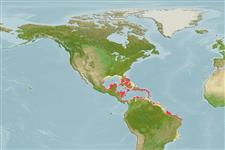>
Eupercaria/misc (Various families in series Eupercaria) >
Haemulidae (Grunts) > Haemulinae
Etymology: Haemulon: Greek, haimaleos = bloody (Ref. 45335).
Environment: milieu / climate zone / depth range / distribution range
Ecología
marino asociado a arrecife; oceanodromo (Ref. 51243); rango de profundidad 3 - 30 m (Ref. 9626). Subtropical; 31°N - 30°S, 98°W - 34°W
Western Atlantic: Bahamas, Florida (USA), and northern Gulf of Mexico to Brazil.
Tamaño / Peso / Age
Maturity: Lm ? range ? - ? cm
Max length : 41.2 cm TL macho / no sexado; (Ref. 9626); common length : 30.0 cm TL macho / no sexado; (Ref. 3798)
Espinas dorsales (total) : 12; Radios blandos dorsales (total) : 16 - 18; Espinas anales: 3; Radios blandos anales: 8. Silvery, the edges of the scales narrowly brown, the centers on upper half of body with a spot which may vary in color from yellow through bronze to dark brown (forming oblique dotted lines following scale rows) (Ref. 13442).
Inhabits shallow coastal reefs, the young on seagrass beds, adults in schools in relatively open areas (Ref. 9710). Rare at oceanic islands (Ref. 9710). Feeds at night on mollusks and small fishes (Ref. 9710). Marketed fresh (Ref. 3798).
Life cycle and mating behavior
Maturities | Reproducción | Spawnings | Egg(s) | Fecundities | Larva
Oviparous, distinct pairing during breeding (Ref. 205).
Robins, C.R. and G.C. Ray, 1986. A field guide to Atlantic coast fishes of North America. Houghton Mifflin Company, Boston, U.S.A. 354 p. (Ref. 7251)
IUCN Red List Status (Ref. 130435)
Threat to humans
Harmless
Human uses
Pesquerías: escaso valor comercial; Acuario: Acuarios públicos
Herramientas
Special reports
Download XML
Fuentes de Internet
Estimates based on models
Preferred temperature (Ref.
123201): 25.6 - 28.2, mean 27.4 °C (based on 724 cells).
Phylogenetic diversity index (Ref.
82804): PD
50 = 0.5000 [Uniqueness, from 0.5 = low to 2.0 = high].
Bayesian length-weight: a=0.01318 (0.00824 - 0.02108), b=3.01 (2.87 - 3.15), in cm total length, based on LWR estimates for this species & Genus-body shape (Ref.
93245).
Nivel trófico (Ref.
69278): 3.5 ±0.2 se; based on diet studies.
Generation time: 4.6 ( na - na) years. Estimated as median ln(3)/K based on 1
growth studies.
Resiliencia (Ref.
120179): Medio, población duplicada en un tiempo mínimo de 1.4-4.4 años (K=0.24).
Fishing Vulnerability (Ref.
59153): Moderate vulnerability (37 of 100).
Nutrients (Ref.
124155): Calcium = 21.8 [9.8, 59.1] mg/100g; Iron = 0.531 [0.258, 1.032] mg/100g; Protein = 19.6 [17.6, 21.6] %; Omega3 = 0.148 [0.067, 0.287] g/100g; Selenium = 14.3 [6.4, 29.5] μg/100g; VitaminA = 34.6 [9.2, 127.5] μg/100g; Zinc = 0.681 [0.413, 1.102] mg/100g (wet weight);
